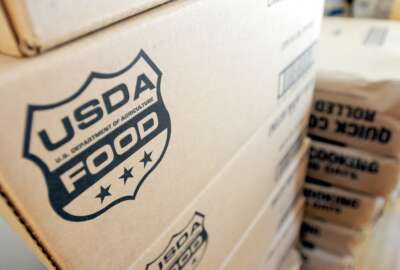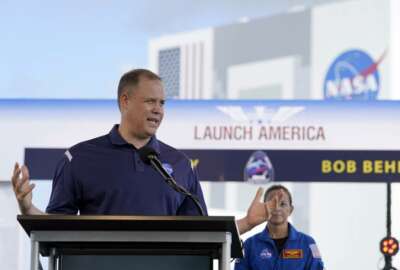

NASA recently awarded 17 small companies more than $14 million to keep developing promising new technologies. They're already shown promising results in the fir...
Best listening experience is on Chrome, Firefox or Safari. Subscribe to Federal Drive’s daily audio interviews on Apple Podcasts or PodcastOne.
NASA recently awarded 17 small companies more than $14 million to keep developing promising new technologies. They’re already shown promising results in the first round of funding. With the latest on NASA’s and Small Business Technology Transfer and Small Business Innovation Research programs, Federal Drive with Tom Temin turned to the acting program executive Gynelle Steele.
Interview transcript:
Tom Temin: Ms. Steele, good to have you on.
Gynelle Steele: Thanks for having me, Tom.
Tom Temin: So this is a long standing program, it’s really two programs that are interrelated. Just give us the architecture of the program and a little bit of the history.
Gynelle Steele: Absolutely. So STTR stands for Small Business Technology Transfer program. And we support and fund American small businesses in partnership with research institutes, that have a desire to further relevant research and build capacity for NASA, the commercial aerospace industry in the nation as a whole. The program is run jointly with this sister program, the NASA Small Business Innovation Research Program, or SBIR. But the main difference between the two is that STTR requires a small business to partner with a research institute. Whereas the SBIR program is open to just any small business, no partnership is required. Our program’s goal is to introduce new technologies and ideas when and where they are needed most. So we fund technologies and invest in small businesses and research institutes in all 50 states, including Puerto Rico throughout the year through our phase one and phase two program, but also through our post phase two opportunities. The STTR program in particular is run in three phases. Phase One is called our idea generation phase, and these contracts lasts for 13 months with a max funding of 125k. In this phase, the Small Business and Research Institute will have the opportunity to establish the merit and feasibility of their proposed innovation, but they don’t need to necessarily deliver anything physical. Phase two focuses on actually developing and demonstrating and delivering the innovation. And we call this our prototype phase. But these contracts last then for 24 months with a maximum funding of 750k. This is the phase that we’re talking about today that we just awarded right before the end of the calendar year.
Tom Temin: Sure. So I guess these programs then give a real good clue into what NASA writ large is interested in developing on the technology front. Give us some highlights of the second phase of funding.
Gynelle Steele: The 750k demonstration and development is really where a lot of the prototypes that will meet some of NASA’s missions are specified. If you go to our website over at sbir.nasa.gov we talk about three particular technologies under STTR that were just awarded. One is with a company called Plasma Processes. This is a veteran owned small business out of Huntsville, Alabama. And they’re going to be partnering with Georgia Tech and developing a dual mode green propulsion system. This has always been one of our major focuses for us to develop propulsion systems that can help with our missions. This is a technology that would gear us towards that. There’s another company we talked about on the website called H2O Insights. And this is a woman owned small business and a first time awardee under our NASA STTR program. They’re located in Scottsdale, and they’ll partner with Arizona State University in Tempe to develop a novel optical fiber. And then we have the last one that we mentioned on the website is Multi3D, a first time awardee This is a recipient out of Cary, North Carolina. and they’ll partner with Duke University in Durham, North Carolina to create a meta surface antenna that will help future NASA missions map water content on the lunar surface and the Earth.
Tom Temin: And when you go back to Plasma Processes here for a moment, this is for green propulsion, I guess, plasma, whatever that is, has something to do with this propulsion. But could this potentially result in a way that could help rockets maneuver in space at some point?
Gynelle Steele: So this is a technology where NASA and any future commercial clients could use this system for missions requiring attitude and orbit control, reaction control and formulation flying and controlled reentry. It’s primarily for manipulating and being able to direct the spacecraft.
Tom Temin: In other words, NASA will still have to burn large amounts of regular fuel to get out of this world, but once you’re up there and getting back maybe there’s some new ways to do it.
Gynelle Steele: There are some very new innovative ways that we’re looking at actually dealing with maneuvering spacecraft. The process of getting out of space requires such a large amount of thrust, but I know that we’re also looking at a green technologies for that. But I think more importantly, we’re trying to go into the areas of where we can find technology demonstrations and maneuvering smaller thrust type of applications.
Tom Temin: And when you conceive of one of these rounds of funding, one, two and three, how do the companies get picked? How do the technologies needed get zeroed in on? Is that something that your program can do alone or do you involve the primary NASA mission owners in this process?
Gynelle Steele: Absolutely. Yeah, so our program, the SBIR and STTR program technically falls under one of the agencies four mission directorates, the Space Technology Mission Directorate. But we’re tied to everything that NASA does through our solicitation. We cover human exploration, space technology science and aeronautics. So our phase two awardees will develop technologies across all of NASA’s spectrum. Of course we’re going to make sure that these companies are geared in to help the agency achieve its Artemis mission, which is landing the first woman and the next man on the moon by 2024. So we’ve selected multiple technologies that have the potential benefit for NASA’s Lunar mission. Electric propulsion systems, the antenna we talked about, the water content on a lunar surface that we talked about. So all of these are geared towards what our missions are across all of our mission directorates.
Tom Temin: And one of the companies H20 Insights, again looking that you mentioned and looking at your website describing them that says they are looking into the ability of ultraviolet lights to disinfect bacteria on the space station. But this could have a lot of application here on Earth in a lot of ways. And given the fact that there is so much commercial development going on in space, some of these propulsion systems and so on could work for commercial operators of spacecraft and not just NASA. Is that one of the guiding principles that these have multiple use technologies?
Gynelle Steele: Absolutely. When we define our subtopics, we look for those technologies that of course have a benefit for the missions that we’re working on, but also will serve the small business because the ultimate goal is that they make an impact on the nation’s economy. And so we are looking for those technologies that could have terrestrial benefits. And most of our applications our small businesses are finding that while we’re making it for, as you said, H20 is making it for disinfecting on the International Space Station, it also has applications here through the appliances and biomedical devices and things of that sort. That’s our goal and that’s our win win situation where we can find a need for technologies that small businesses can deliver for us, but also have a potential marketplace here.
Tom Temin: Do the companies that got the awards, were they working on these technologies specifically for NASA in the first place? Or did they have something they were working on commercially that got NASA’s attention and their attention, and you said we might be able to dance here?
Gynelle Steele: We find that they can be in a lot of different areas, Tom. They can be companies that had some thoughts of hmm my technology might be beneficial to NASA. We sponsor a innovation and opportunity conference every year. And we lay out a lot of our needs at that innovation and opportunity conference, which hopefully sparks some interest in the small businesses as to what they’re working on that we might also have a need for. So the synergies are usually there, and it helps when there is some existing synergy between what they’re working on and the applications that we have. But we also advise companies that might be coming brand new to NASA to look at our past solicitations, see where we have funded technologies before. To give you a better idea of what we’re looking at, we do right now, and our solicitation just closed on Friday, but we have a communications blackout timeframe from the time the solicitation opens to when awards are made. After that, you’re open to talk to any of the NASA subject matter experts and really understand and get a deep dive into not only the particular technology that was asked for in the solicitation, but the broader applications that we’re looking for. So as much research and homework that you can do on some of our needs, based on the capabilities of those companies, helps making that connection.
Tom Temin: And these companies that are small, do they also tend to be in the startup or research oriented phase as opposed to they’ve been around for 25 years producing some particular technology?
Gynelle Steele: They’re both. We are attracting more of the growth oriented startup companies than we have had before. We also have a space topic that we run in connection with the National Science Foundation, and they focus primarily on growth oriented and startup companies. So we’re covering both the waterfronts through what we do and what they do. But yeah, we can see everything from early stage startup company to one that’s been around for a while proposing and actually getting awards.
Tom Temin: I imagine that gives you faith in American innovation to see these parades of companies coming through your agency program.
Gynelle Steele: Absolutely. It’s an exciting opportunity. Again, the amount that we put in making sure that our subtopics are looking to address both the needs that the nation has to our mission, but also with those terrestrial benefits. We’ve seen a couple of companies get acquired and get bigger from working through our technology. One of the things working with NASA does for small businesses, it does say that your technology has been vetted. We do a lot of work to make sure that the technologies that you are developing, the small businesses are developing, are addressing what we need. We have very stringent requirements because we’re trying to take these technologies to space, so they’ve got to be rad hard. They’ve got to do a lot of things that aren’t necessarily what you would need to do terrestrially to sell the application. So it just is a further vetting of that technology.
Tom Temin: Gynelle Steele is deputy Program Executive of the Small Business Technology Transfer and Small Business Innovative Research Programs at NASA. Thanks so much for joining me.
Gynelle Steele: Thank you for having me.
Copyright © 2024 Federal News Network. All rights reserved. This website is not intended for users located within the European Economic Area.
Tom Temin is host of the Federal Drive and has been providing insight on federal technology and management issues for more than 30 years.
Follow @tteminWFED



